
* The USA fielded a number of floatplanes during World War 2. Among the most successful were the Grumman "Duck" -- used primarily in the utility and air-sea rescue (ASR) roles -- and the Vought Kingfisher -- used primarily in the fleet observation role. This document provides a history and description of the Duck and Kingfisher.
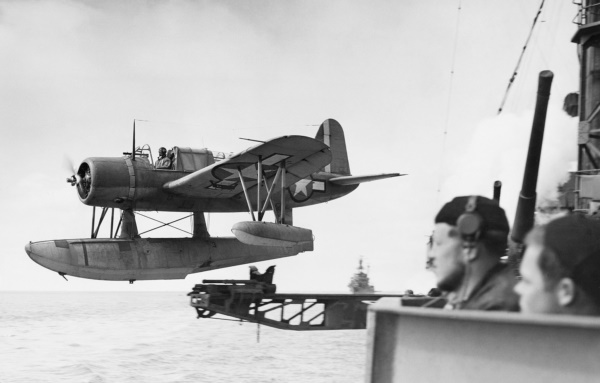
* Leroy Grumman worked in aircraft design at the Loening Aircraft Engineering Corporation in New York City in the 1920s. When Loening was bought out by Keystone Aircraft and its operations moved to Bristol, Pennsylvania, Grumman and a number of other Loening employees decided to stay, moving to a factory on Long Island. The new firm was called the "Grumman Aircraft Engineering Corporation". Grover Loening, boss of the original firm, helped set up the new company, providing financial backing.
The Grumman company started out making floats for seaplanes, licensed from Loening designs. In order to bring in new business, the Grumman company designed a scout / utility floatplane -- based on a Loening design, the "X02L-1", that Loening didn't have the resources to produce himself -- with the initial "XJF-1" performing its initial flight on 24 April 1933, Grumman test pilot Paul Hovgard at the controls. Following successful evaluation, the US Navy ordered an initial batch of 22 "JF-1" floatplanes, with initial deliveries in 1934. Five more were ordered later.
The JF-1, as it emerged, was made primarily of aircraft aluminum alloy, except for fabric-covered flight surfaces; it was built very rugged, as were other Grumman aircraft, the company becoming known as the "Iron Works". The JF-1 was a biplane with a central float and a strut-braced outrigger float under each wingtip. The wings had equal span; each wing had a single set of struts and wire bracing. The central float was integrated into the fuselage, to the extent that the Duck might be seen as almost a flying boat, not a floatplane.
The JF-1 was amphibious; the central float had a fixed tailwheel at the end, which doubled as a water rudder, and there were hand-cranked mainwheels forward that pivoted down the across the sides of the float. There was a carrier arresting hook under the tail, with the JF-1 also built for catapult launch off of battleships. There was a single bomb rack under each wing, with a rack able to carry up to 45 kilograms (100 pounds) of bombs or a depth charge.
The JF-1 was powered by a Pratt & Whitney (PW) R-1830-62 Twin Wasp Junior 14-cylinder two-row air-cooled radial engine with 520 kW (700 HP), driving a three-bladed Hamilton Standard variable-pitch constant-speed propeller. The XJF-1 had used the same powerplant. Performance, for the time and for what it was, was excellent, the JF-1 having an impressive rate of climb.
There were two crew in a tandem cockpit with an enclosed canopy. The pilot sat forward, with an observer in the back; a 7.62-millimeter (0.30-caliber) Browning machine gun could be fitted on a flexible mount on the rear of the cockpit for defense. The two crew had their own sliding canopy sections for getting in and out, with handholds on the sides of the fuselage to allow them to get up and down. There was a hold beneath the observer's position for two passengers. There was access to the hold through the rear cockpit, and a sliding window on each side. Some sources claim a third seat could be fitted in the cockpit for a radio operator if the rear machine gun weren't fitted, but it would seem like a tight fit.
* The JF-1 was followed by nine unarmed "JF-2" machines for the US Coast Guard (USCG); they were different mainly in the replacing the PW Wasp Junior engine with a Wright nine-cylinder air-cooled R-1820-102 Cyclone engine, with 520 kW (700 HP). Being a single-row engine, the engine cowling was well shorter than that of the JF-1, with the cowling featuring curved instead of straight sides. The JF-2s had a radio direction-finder loop antenna on top of the rear fuselage; the loop antenna had to be removed if the rear machine gun were fitted. The JF-2s didn't have the arresting hook, since they didn't fly off carriers. Six more JF-2s were obtained with the R-1820-08 Cyclone, with 560 kW (750 HP); they also featured a revised tailplane, and some tweaks to the flight control surfaces.
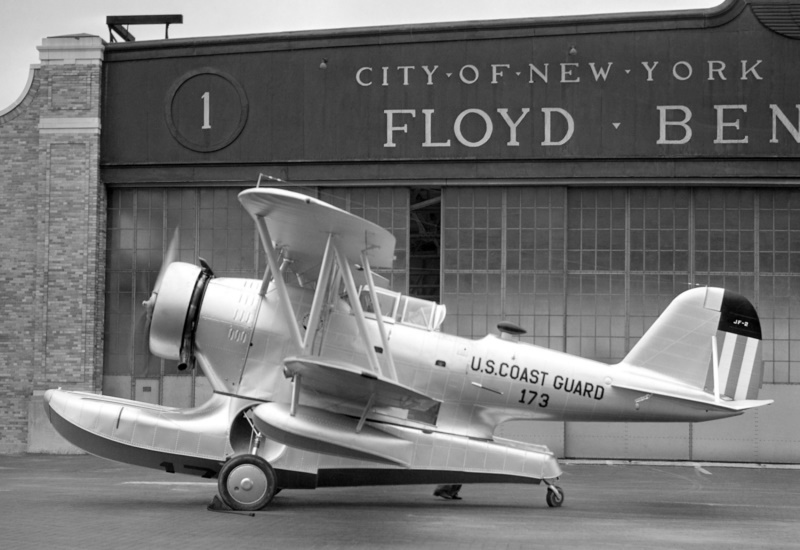
One of these six JF-2s was transferred directly to the Navy; the Navy also obtained five "JF-3" machines to the same spec, intended for shore operations, also without the arresting hook. They could be fitted with both the loop antenna and the machine gun, the loop antenna being mounted in the cockpit between the front and back seats. In 1937, Argentina obtained eight unarmed machines as the "Grumman G-20". That gave total production of 56 JF-series machines, including the prototype.
BACK_TO_TOP* Production switched to the improved "J2F-1" in 1936. The J2F looked much the same as the JF, the primary change being a bigger fuel supply to improve range. The J2F was also more of a multi-role machine, with kit to allow it to be used for aerial reconnaissance, target-towing, smoke-laying, or for medical evacuation -- with a single stretcher in the hold.
The float was extended forward by 30 centimeters (a foot) to compensate for the greater maximum take-off weight (MTOW). As a recognition feature, the connection between the float and the fuselage was extended almost to the rear end of the float. There were other small modifications, including updated ailerons. It was powered by an R-1820-20 Cyclone, which offered 560 kW (750 HP) -- meaning no increase in power, leaving the J2F-1 underpowered. The J2F-1 had the arresting hook, and no catapult capability; it could carry a heavier bombload. 29 J2F-1s were built to 1937.
The "J2F-2" was much the same, but featured an uprated Wright Cyclone providing 590 kW (790 HP). It also had a forward-firing 7.62-millimeter Browning firing forward through the engine cylinders. 30 were built, mostly for the Marines. Nine were modified to "J2F-2A" standard, with dual Brownings in the rear cockpit and two bomb racks under each wing. The "J2F-3" was effectively an unarmed J2F-2 with VIP accommodations in the passenger compartment, with 20 built in 1939. They were painted in snappy colors of blue and silver.
The J2F-3s were followed by 32 "J2F-4" machines for the US Navy, similar to the J2F-2, with small tweaks. Argentina also obtained four "G-15" machines, equivalent to the J2F-4, in 1939. The last Grumman-built J2F was the "J2F-5", which was a J2F-4 powered by an R-1820-50 Cyclone with 670 kW (900 HP). It restored the long-chord cowling, due to the relocation of the oil cooler to the engine compartment. They could carry a 150-kilogram (325-pound) depth charge or other stores under each wing. The J2F-5, incidentally, was the first of the series to be formally named the "Duck". Grumman produced 144 in 1941 and early 1942.
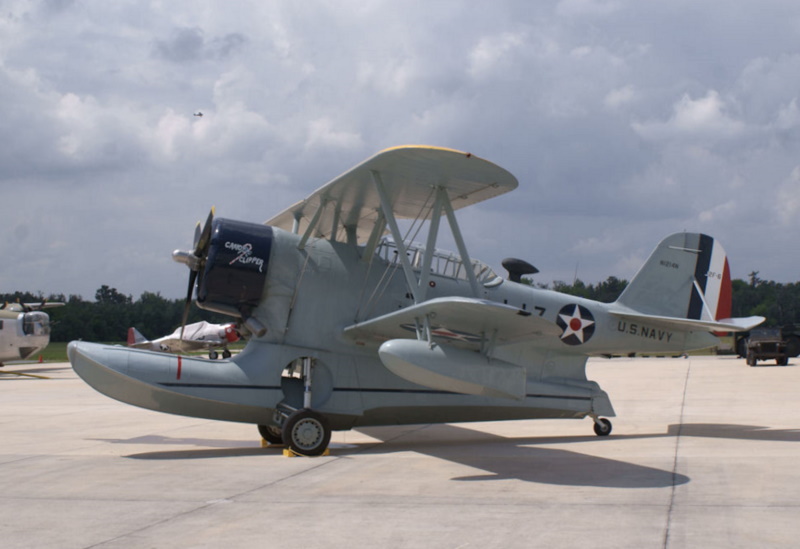
Following the entry of the USA into World War II in December 1941, Grumman's production facilities were switched to other aircraft, and so production of the J2F was transferred to the Columbia Aircraft Corporation, nearby on Long Island. Columbia built 330 "J2F-6" machines, much like the J2F-5, but with an R-1820-54 Cyclone with 785 kW (1,050 HP). They went to the US Navy and Coast Guard. Production of the Duck persisted up to the end of the war -- not bad for an antique-looking biplane.
___________________________________________________________________
GRUMMAN J2F-6 DUCK:
___________________________________________________________________
wingspan:
11.89 meters (39 feet)
wing area:
38 sq_meters (409 sq_feet)
length:
10.37 meters (34 feet)
height:
4.25 meters (13 feet 11 inches)
empty weight:
1,995 kilograms (4,400 pounds)
MTO weight:
3,495 kilograms (7,700 pounds)
max speed:
305 KPH (190 MPH / 165 KT)
cruise speed:
250 KPH (155 MPH / 135 KT)
service ceiling:
7,620 meters (25,000 feet)
range:
1,205 kilometers (750 MI / 650 NMI)
___________________________________________________________________
The Duck performed sterling service during the conflict, in particular in the air-sea rescue role. It doesn't appear that they were much operated off of battleship catapults, instead operating off shore bases or carriers. Ducks used on small escort carriers were sometimes fitted with "rocket-assisted take-off (RATO)" gear to help them get off the deck -- leading to the image of a rocket-powered biplane.
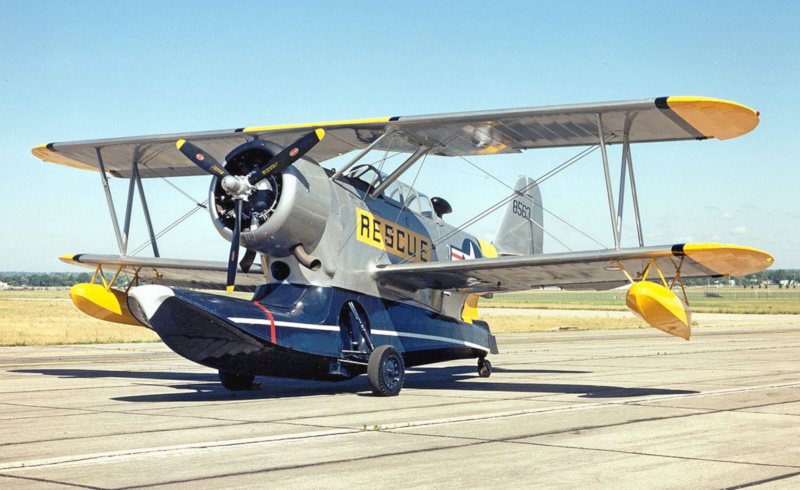
After the war, a number of J2F-5/6 machines were used by the US Air Force in the ASR role as the "OA-12", featuring minor modifications, these aircraft mostly serving in Alaska. Argentina obtained 32 hand-me-down Ducks; recycled machines were also supplied to Colombia (3), Mexico (3), and Peru (1). A Duck played a prominent role in the 1971 movie MURPHY'S WAR, with Peter O'Toole. A number of Ducks survive, some of them being flight-worthy.
Grumman considered an improved follow-on to the Duck, the "JL-1", with Columbia building two "XJL-1" prototypes, and performing trials with them in 1946. They were broadly along the lines of the Duck, but gull-wing monoplanes; they had retractable tricycle landing gear, the nose gear retracting backward into the front of the float, the long main gear retracting in the wings in towards the fuselage. There was no interest in the JL-1, and the two prototypes ended up being sold off. One ended up in the Pima Air Museum in Tucson, Arizona.
BACK_TO_TOP* Chance M. Vought got started in aviation as an engineer in the Wright Corporation. In 1917, he collaborated with Birdseye Lewis to establish the "Lewis & Vought" aircraft company in Astoria, New York. The company relocated to Long Island City, New York, in 1919; Lewis retired in 1922, with the firm then renamed to the "Chance Vought Corporation". It specialized in single-engine naval aircraft, most prominently the "O2U Corsair" scout / observation biplane.
Vought was bought up by the United Aircraft Corporation in 1928, to become a distinct division of the group. Vought himself died in 1930, but the company kept on without him. In 1934, the company developed a biplane observation floatplane, the "O5U" for a Navy competition; only one was built, the award being give to Curtiss for what would become the "SOC Seagull".
In 1938, the company developed a new floatplane for another Navy requirement, specifying a monoplane floatplane, capable of a range of tasks, but with a focus on catapult launch off of battleships and cruisers for scouting and fire direction. A team under Vought engineer Rex B. Beisel cooked up a design, the VS-310", of mostly-metal construction, with a radial , a low wing, plus centerline and outrigger floats. A single prototype of the "XOS2U-1" performed its initial flight on 1 March 1938, with Paul S. Baker at the controls. The prototype proving successful, the Navy ordered a batch of "OS2U-1 Kingfisher" floatplanes.
The OS2U-1 was very much like the prototype. This machine was powered by an air-cooled, two-row, 14-cylinder PW R-985-48 Twin Wasp, with 335 kW (450 HP), driving a two-bladed variable-pitch propeller -- the prototype had been powered by the similar R-985-4 variant. As noted, it was a low-wing monoplane, largely of metal construction -- except for fabric-covered wings rear of the single wing spar, and fabric-covered control surfaces. It featured riveting and spot welding in its construction; spot welding was a new technology, which reduced drag and buckling, buckling being a problem with catapult-launched aircraft. Flight control surfaces included one-piece flaps; "drooping" ailerons that could act like flaps; spoilers for roll control when the flaps were drooped; plus rudder, ailerons, and trim tabs.
The two crew sat in tandem, the observer having extensive glazing, with canopies sliding towards the center. There was a 7.62-millimeter (0.30-caliber) machine gun firing forward in the nose, the pilot using a telescopic sight for aiming, and another Browning, firing to the rear on a ring mount.
54 OS2U-1s were built in all, being provided to the US Navy from August 1940. They were followed by the "OS2U-2" -- a modestly improved variant, effectively indistinguishable from the OS2U-1, the most significant change being a PW R-985-50 Twin Wasp, with the same power ratings as the -48 variant. 158 were built, mostly being for flight training, but about a third of them seeding "Inshore Patrol Squadrons", which provided coastal patrol against German submarines.
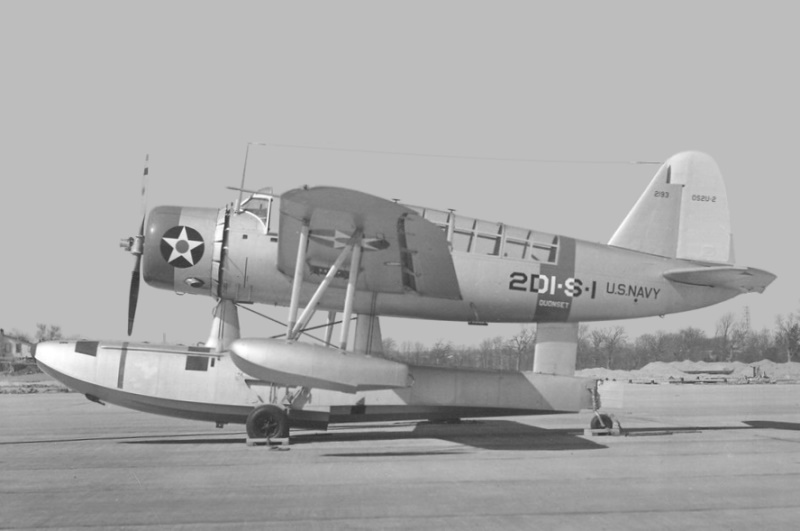
The OS2U-2 was followed in turn by the "OS2U-3", an improved version of the OS2U-2, with an R-985-AN2 engine -- again, no power increase -- plus armor and self-sealing fuel tanks, with more fuel capacity. It could carry depth charges or bombs on underwing racks, maximum external warload being 295 kilograms (650 pounds). Vought built 1,006 OS2U-3s; the Naval Aircraft Factory also built 300 of them as the "OS2N-1", these mostly being used to build up Inshore Patrol Squadrons. The Naval Aircraft Factory also assembled some Vought-built OS2U-3s, those being included in the tally of 1,006.
___________________________________________________________________
VOUGHT OS2U-3 KINGFISHER:
___________________________________________________________________
wingspan:
10.95 meters (35 feet 11 inches)
wing area:
24 sq_meters (262 sq_feet)
length:
10.31 meters (33 feet 10 inches)
height:
4.61 meters (15 feet 2 inches)
empty weight:
1,870 kilograms (4,123 pounds)
MTO weight:
2,720 kilograms (6,000 pounds)
max speed:
265 KPH (165 MPH / 140 KT)
service ceiling:
3,960 meters (13,000 feet)
range:
1,295 kilometers (805 MI / 650 NMI)
___________________________________________________________________
In addition, there were two "OS2U-4" machines, but they were experimentals -- with long, slender wings and full-span flaps. The OS2U-4 didn't go into production. That gave total OS2U production as 1 + 54 + 158 + 1,006 + 300 + 2 == 1,521 aircraft.
The Kingfisher was not only flown by the US Navy, but also the US Marine Corps and US Coast Guard. The Kingfisher provided excellent service in its primary role as a catapult-launched fire-controller / scout for battleships and cruisers. The catapults were powered by a large blank shell shoved into a breech; in other words, a floatplane was literally fired off the ship. Apparently, pilots found the take-offs fairly straightforward.
The floatplane landed in the ship's wake, which was relatively calm, to then taxi onto a canvas recovery sled, and then be hoisted up onto the ship. The hoisting procedure was tricky and could be hazardous, particularly in rough seas; the seas might be calm when the aircraft was launched, not so calm when it returned. Finding the ship in foul weather or darkness could also be troublesome, since in a combat zone the ship generally couldn't turn on a radio homing beacon or otherwise advertise its presence. As the war went on, Kingfishers served more as scouts than gunnery spotters, since radar took over the gunnery targeting role.
Along with battleships and cruisers, Kingfishers were operated off seaplane tenders, as well as a number of destroyers. Destroyer use was somewhat problematic, since they didn't generate enough of a wake for a (relatively) safe landing. The OS2U also proved useful in the coastal patrol role, two Kingfishers being credited with assisting in the destruction of German U-boat U-576 off of Cape Hatteras on 15 July 1942. Incidentally, one OS2U was credited with shooting down a Japanese Mitsubishi Zero fighter in early 1945.
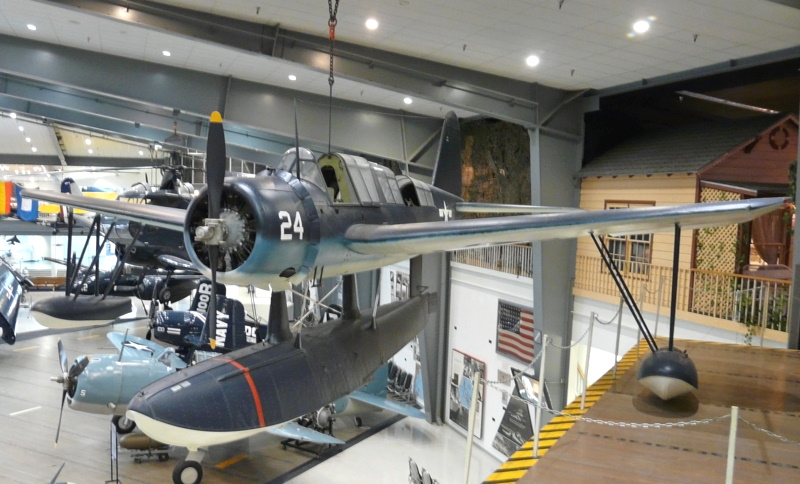
The Kingfisher was particularly useful in the ASR role. In one notable incident, in 1941, a Kingfisher rescued World War I ace Eddie Rickenbacker and his crew after they ditched their aircraft in the Pacific. In another significant incident, on 30 April 1944, Navy Lieutenant John A. Burns rescued ten airmen from Truk Lagoon by loading them on his wings and taxiing out to sea to the submarine USS TANG; he made two trips, with the damaged Kingfisher sinking after the rescue.
The Dutch ordered 24 Kingfishers for the Dutch East Indies, which were never delivered after the Japanese conquered the Dutch possessions in the Far East. 18 of the order ended up in Australia -- what happened to the other six aircraft is not know -- where they were initially used for training flying-boat pilots, but then were put on convoy-escort duties, being used in that role through the war. Britain also obtained 100 OS2U-3 machines, giving them the designation of "Kingfisher Mark I", these aircraft being flown by the Royal Navy FAA for training, and for ship-launched scouting.
After the war, Kingfishers were also supplied to Chile (15 aircraft), Cuba (4), Dominican Republic (3), Mexico (6), and Uruguay (6). The OS2U was supposed to have been replaced by the Curtiss S03C Seamew, but the Seamew was a dreadful aircraft, ranked among the worst to ever reach production. The OS2U was finally replaced in US service from late 1944 by the substantially better Curtiss SC Seahawk. The type lingered in service into the late 1950s in Latin America. None are still flying, but a number survive as static displays.
BACK_TO_TOP* Sources include:
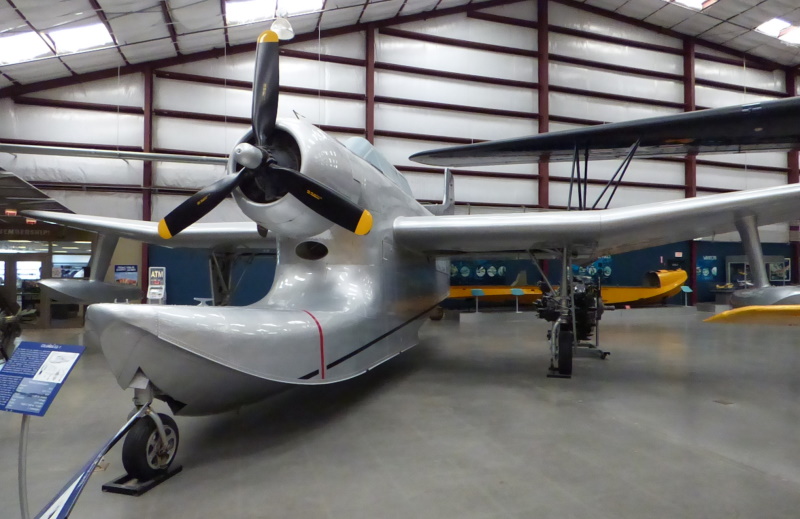
* Illustrations details:
* Revision history:
v1.0.0 / 01 may 20 v1.0.1 / 01 mar 22 / Review & polish. v1.0.2 / 01 feb 24 / Review & polish. (+)BACK_TO_TOP
